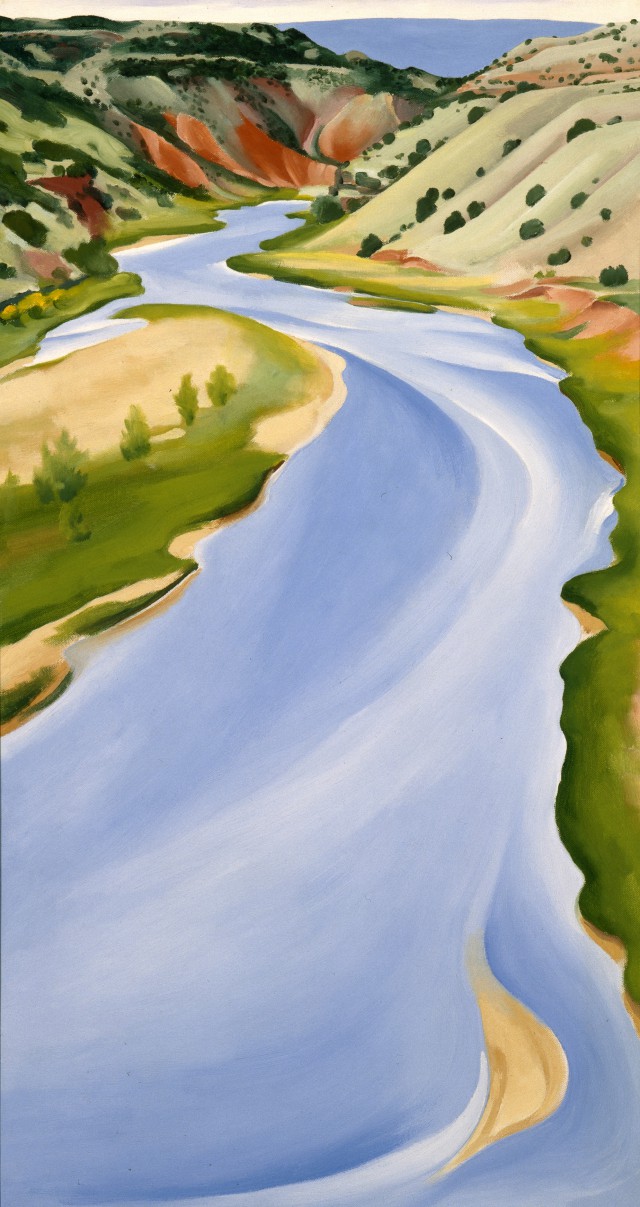
On a wintry afternoon in New York state, far from her beloved New Mexico and its ochre, umber and rust palette, the color and line that had drawn her in and kept her coming back, Georgia O’Keeffe sat painting the piece of that landscape she could bring with her when she came home to the New York City art scene and her husband, Alfred Stieglitz, and his gallery there. As it snowed, she painted “Kokopelli with Snow,” a katsina tihu doll with his chin tucked toward an invisible flute, his red, brown and black plumage flaring upward toward a blue and white blur of sky and a few white dots. It was 1942, some 13 years after O’Keeffe had started spending a portion of the year in New Mexico. What she found there was very much what she found in the katsina tithu, sacred objects from the Hopi tribes of the Southwest. She found a thing that matched what she was seeking as an artist: a study of line, form and color that meant reducing the realism in favor of evocative images that border on abstractions.
O’Keeffe was among the early artists — of any gender — to play with those lines. Three paintings done between 1936 and 1945 of a spot she called “The Black Place” in New Mexico show her beginning with a recognizable landscape of those coal-blacked cliffs and arroyos touched with pink, blue and green, then charging so far into abstraction that the gully becomes a jagged line in near monochromatic black and white, then backing out to a roughed but less abstract landscape, and a less tight zoom.
The interplay and exploration of form, color and contour are among the aspects of O’Keeffe’s work not named in the exhibition Georgia O’Keeffe in New Mexico: Architecture, Katsinam and the Land, currently on view at the Denver Art Museum.
“Hill, New Mexico,” from 1935, from a private collection
What O’Keeffe found, when she came to New Mexico, was a place where her study of line moved from the verticals of the New York City skyscrapers that championed America’s rise as an industrial power to the horizontal adobe structures and mesas of New Mexico — another American icon, but one much more about native people and ancient traditions than the rise of a new world superpower. What she said of her first trip to New Mexico was that she had found a place that matched her perfectly.
“She had this great quote that, ‘The first time I came to New Mexico, I knew this place was mine,’ and something to the effect of, ‘It matched me just perfectly,’” says Thomas Smith, director of the Petrie Institute of Western American Art at the Denver Art Museum. “So I think it was that instant thing, and I think we’ve all experienced that from time to time. You find some place that you’re like, ‘Oh wow, this is my spot,’ and I think that happened to her.”
“Blue-Headed Indian Doll” from 1935, Georgia O’Keeffe Museum, gift of The Burnett Foundation
The exhibition was curated around a sense of place, of understanding O’Keeffe and what New Mexico meant for her, and will tour museums around the country. But at the Denver Art Museum, what Smith and John Lukavic, associate curator of native arts, have been able to add is an influx of Native American art, drawn from the museum’s collection. The Denver Art Museum began collecting American Indian art in the 1920s — it was one of the first art museums to do so — and now has some 20,000 art objects by Native Americans. Among them are the katsina tithu, also referred to as kachina or katsina dolls, which represent spiritual beings that visited the Hopi tribes of the Southwest each year during the harvest.
O’Keeffe did a total of 17 paintings of katsina tithu, and the exhibition includes 15. They have rarely been exhibited, much less shown side by side with the katsina tithu, whose forms, colors and lines show how truly O’Keeffe was engaging with those artworks.
“It’s a sort of curious aspect to her work in that she didn’t talk about them much, she didn’t write about them much — she did a little bit. But also she didn’t exhibit these works, and so no one has really ever studied them and they’ve never really been presented together like this,” Smith says. “So it’s kind of a curious thing. You’re going, ‘OK, why was she attracted to these? Why did she paint them?’ And I think there are some obvious answers to that, the first being, she found them really beautiful objects. I mean she was really interested in them for their aspects, like their color and forms, all the things that she was thinking about. She’s thinking about color, she’s thinking about form, and she looks at churches and architecture and landscape, and then here are these katsina that have great form and color and abstract design. It’s just again, the idea of matching — it’s just the perfect natural match.”
“Church Steeple” from 1930, Georgia O’Keeffe Museum, gift of The Burnett Foundation
Far from the ethnographic cataloguing artists often undertook at the turn of the 20th century, seeking to preserve native cultures before they vanished, O’Keeffe’s interest appears to be one solely of artistic merit.
“Maybe at first you could see that as sort of naïve,” Smith says. “I see that as just the opposite. It’s sort of her acknowledgement of this native art form and the understanding of line and form and color that native artists had, and something that she’s trying to develop herself. These people and these objects — it was already there. They had it and they understood it.”
“Kachina” from 1934, Georgia O’Keeffe Museum from a private collection
O’Keeffe — who had lived for years in New York before an invitation to Taos in 1929 brought her to New Mexico for more than a stopover on a train — had been searching for a place that held a personal connection for her, visiting Texas and Colorado’s Rocky Mountain National Park. Her home in New York was filled with the busy life of Stieglitz’s art galleries or, when they retreated to Lake George, N.Y., crowded by his extensive family.
“The noise and confusion of the Stieglitz family there, and that of visits from Stieglitz’s friends, compromised the quiet and solitude O’Keeffe needed for her work,” Co-Curator Barbara Buhler Lynes wrote in the introduction in the exhibition catalogue. “Moreover, she felt increasingly stifled by that environment and determined that she needed to work in a place that held meaning for her and would provide her with fresh inspiration.”
New Mexico gave so much more than a quiet place to work. In an era when American Modernism was searching for distinctly American imagery, it gave O’Keeffe plenty of fodder.
“I think the most important part about the landscape in particular in New Mexico is it matched her ideology of American Modernism just perfectly,” Smith says. “It was just the same way as she said, it matched her personality or matched her ideas about painting and that landscape matched each other just perfectly. The minimization of palette, looking at forms, abstract forms, and depicting something that is realism but doing it in a very abstract way is something that carries through her work forever.”
“Rust Red Hills,” from 1930, Brauer Museum of Art, Valparaiso University, Indiana
Immediately, works like “Red Hills Gray Sky” parse the palette down to rust and white — and little else. “Ranchos Church No. 1” is sand and blue.
“What happens is what you see in this gallery,” says Buhler Lynes’ co-curator, Carolyn Kastner. “She understands that something in this landscape, in these cultures, is so significant she needs contact with it and she needs regular contact with it. So she stayed. … Her cloistered feeling about the East Coast had to do with the painting subjects, with his family, with many different personal aspects, but it was professional as well, but you can see what she found. She shows up and she starts painting feathers and horse shoes and porcelain chickens and the landscape. She’s just on fire. She painted two dozen paintings that summer, and half of them are completely new subjects she’d never painted before.”
“Yellow Cactus,” from 1935. Private collection
That proliferation of work and new subjects in 1929 was more than any previous year.
Kastner points to a patch of “The Mountain, New Mexico,” painted in 1931, where O’Keeffe’s typically meticulous brushwork, where different colors of paint abut without overlapping and under magnification canvas can sometimes be seen between the paint seams, is overtaken by frenetic, layered pink and rust colors of paint and uncharacteristically visible brushstrokes.
“She’s just putting wet paint into wet paint, she’s pushing paint around, she’s electrified by something, I don’t know what, but this is so interesting to me because I think she’s trying to figure out either the structure of the landscape itself or getting the colors right, but something changes her entire style. And by ’31 she has a very clear technique and approach to oil painting and putting her ideas down on canvas. This kind of thing doesn’t happen very often at all. … This is what the abstract expressionists were doing in the ’40s and ’50s, and it’s called expressive because you can see the brush marks, you can see the excitation of it, and I think this is it. She has letters where she writes about ‘all the colors of my palette are out there in the hillside and you would think it’s just a matter of putting them on the canvas, but it’s not.’ And I think that’s it.”
Kastner says, “This landscape, it just electrified her, and trying to figure out how to paint it and how to create the colors is an extraordinary part of her interest.”
Georgia O´Keeffe in New Mexico: Architecture, Katsinam and the Land is as the Denver Art Museum until April 28. The museum is located at 100 W. 14th St., Denver. Visit www.denverartmuseum.org.
Respond: [email protected]














